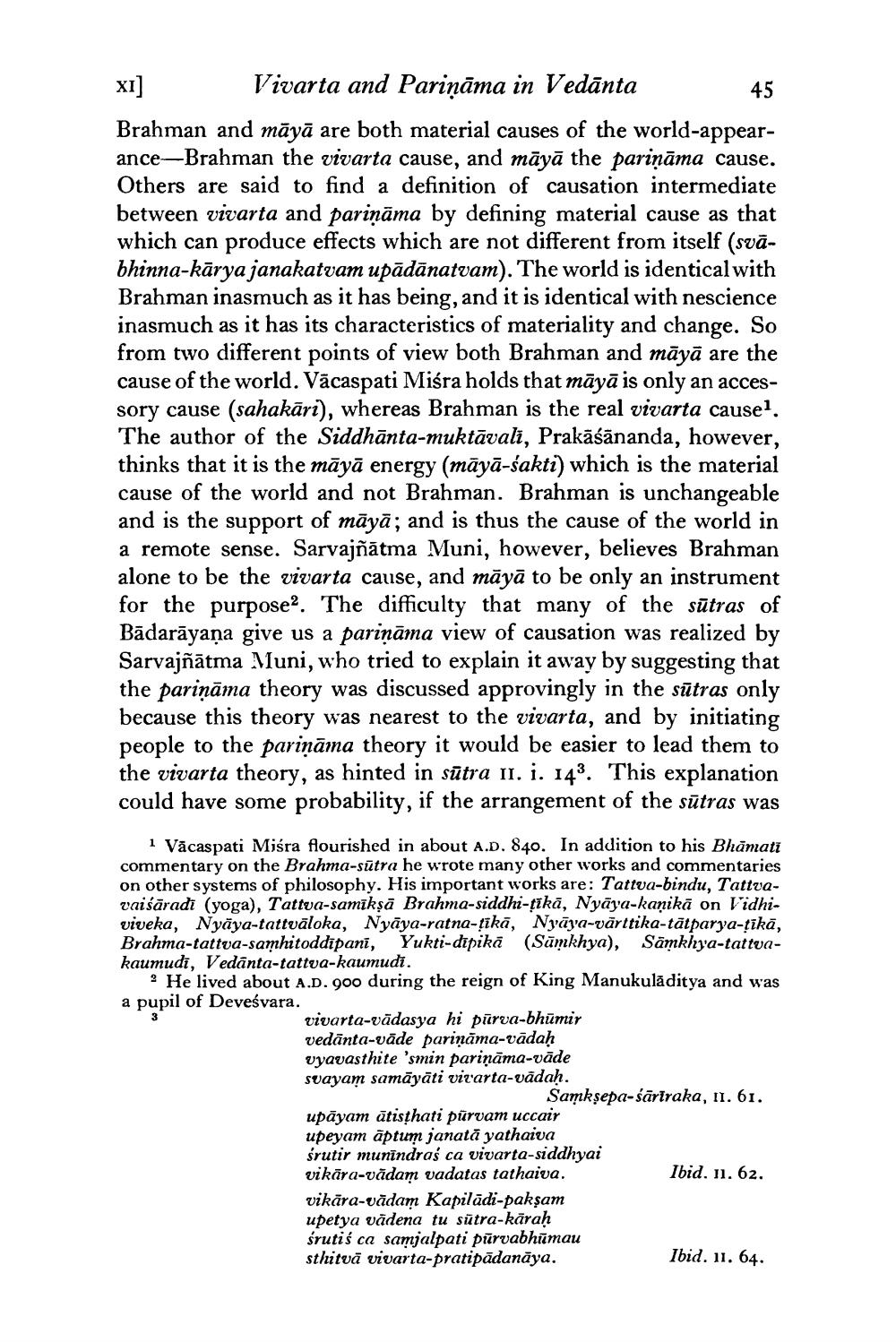________________
XI] Vivarta and Pariņāma in Vedānta
45 Brahman and māyā are both material causes of the world-appearance-Brahman the vivarta cause, and māyā the pariņāma cause. Others are said to find a definition of causation intermediate between vivarta and pariņāma by defining material cause as that which can produce effects which are not different from itself (svābhinna-kārya janakatvam upādānatvam). The world is identical with Brahman inasmuch as it has being, and it is identical with nescience inasmuch as it has its characteristics of materiality and change. So from two different points of view both Brahman and māyā are the cause of the world. Vācaspati Miśra holds that māyā is only an accessory cause (sahakāri), whereas Brahman is the real vivarta cause. The author of the Siddhānta-muktāvali, Prakāśānanda, however, thinks that it is the māyā energy (māyā-sakti) which is the material cause of the world and not Brahman. Brahman is unchangeable and is the support of māyā; and is thus the cause of the world in a remote sense. Sarvajñātma Muni, however, believes Brahman alone to be the vivarta cause, and māyā to be only an instrument for the purpose. The difficulty that many of the sūtras of Bādarāyaṇa give us a pariņāma view of causation was realized by Sarvajñātma Muni, who tried to explain it away by suggesting that the pariņāma theory was discussed approvingly in the sūtras only because this theory was nearest to the vivarta, and by initiating people to the pariņāma theory it would be easier to lead them to the vivarta theory, as hinted in sūtra 11. i. 143. This explanation could have some probability, if the arrangement of the sūtras was
1 Vācaspati Misra flourished in about A.D. 840. In addition to his Bhāmatī commentary on the Brahma-sūtra he wrote many other works and commentaries on other systems of philosophy. His important works are: Tattva-bindu, Tattvavaiśāradi (yoga), Tattva-samīksā Brahma-siddhi-tikā, Nyāya-kanikā on Vidhiviveka, Nyāya-tattvāloka, Nyāya-ratna-ţikā, Nyāya-vārttika-tātparya-tīkā, Brahma-tattva-samhitoddipani, Yukti-dipikā (Samkhya), Samkhya-tattuakaumudi, Vedānta-tattva-kaumudi.
? He lived about A.D. 900 during the reign of King Manukulāditya and was a pupil of Deveśvara.
vivarta-vādasya hi pūrva-bhumir vedānta-vāde pariņāma-vādaḥ vyavasthite 'smin pariņāma-vāde svayam samāyāti vizarta-vādah.
Samksepa-śārīraka, 11. 61. upāyam ātisțhati pürvam uccair upeyam aptum janata yathaiva śrutir munīndraś ca vivarta-siddhyai vikāra-vādam vadatas tathaiva.
Ibid. 11. 62. vikāra-vādam Kapilādi-pakşam upetya vädena tu sūtra-kārah śrutiś ca samjalpati pūrvabhūmau sthitvā vivarta-pratipādanāya.
Ibid. 11. 64.




